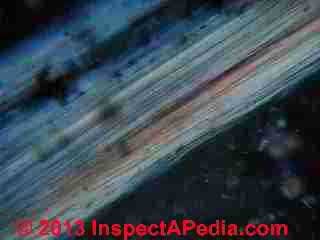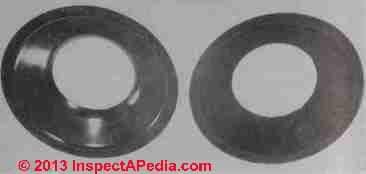 Asbestos Properties
Asbestos Properties
The physical, mechanical, chemical & other characteristics of Asbestos
- POST a QUESTION or COMMENT about asbestos definition, chemical, mechanical, composition, iron content, thermal & other properties
Asbestos characteristics or properties:
This article series describes the physical properties of asbestos including its mechanical, chemical, electrical and related properties both in pure asbestos form and when asbestos is mixed with other materials like cement or rubber. As the author points out, while this is a lenghty article, there is far more detailed information about asbestos properties, chemistry, etc. A separate ASBESTOS BIBLIOGRAPHY gives access to much of that data.
Our articles about the properties, manufacture & uses of asbestos-containing products includes detailed information on the production methods, asbestos content, and the identity and use of asbestos-containing materials. Page top photo: tremolite asbestos in the forensic laboratory ©Daniel Friedman.
InspectAPedia tolerates no conflicts of interest. We have no relationship with advertisers, products, or services discussed at this website.
Characteristics & Properties of Asbestos
 Figure 2.1. Rocket motor aft (asbestos-phenolic insulator) before and after firing at 5,000oF.
Figure 2.1. Rocket motor aft (asbestos-phenolic insulator) before and after firing at 5,000oF.
[Click to enlarge any image]
Introduction
The following text is Adapted from Rosato (1959) p. 37-611 [1] © 2013 InspectApedia.com
The physical, mechanical, chemical, electrical, and related properties of asbestos without such added materials as Cement, rubber, etc., will be reviewed. However, it is important to appreciate that far more data for these afore-mentioned items are available. They are reviewed in the chapters listed at the end of this page - chapters which explain the properties of asbestos when it is combined with various other materials.
These data are directly related to the performance of products or end items; they are more important, inasmuch as more than 95 per cent of the asbestos used is combined with other materials. Some products are never identified as containing asbestos even when as much as fifty per cent of their content is asbestos, e.g., asphalt tile, vinyl tile, and plastics.
Basic properties of raw asbestos are interesting and important, but when the asbestos is combined with other materials, drastic differences may occur.
 Physical and chemical
properties of asbestos (as with many other materials) can be altered; e.g., heat resistance of asbestos
fiber is a very important characteristic; it can produce more
interesting results, however, when it is combined with other
types of materials.
Physical and chemical
properties of asbestos (as with many other materials) can be altered; e.g., heat resistance of asbestos
fiber is a very important characteristic; it can produce more
interesting results, however, when it is combined with other
types of materials.
When asbestos fibers are subjected to a temperature of 1,200°F, their tensile strength values are extremely high. In comparison, tensile strength values of organic and inorganic fibers are completely destroyed or melt between 200 and 900°F.
Figure 2.2. View showing parallel fiber structure of asbestos vein, (Courtesy Johns-Manville-Corp.)
Ultimate tensile strength of chrysotile asbestos fibers is approximately 42,000 psi after two minutes at 1,2Q0°F ; 32 per cent strength retention occurs.
After one hour at 1,200°F, tensile strength drops to 2,000 psi. When the fibers are com- bined with silicone resin to produce structural plastics, the reinforced plastic can retain 50 per cent of its room temperature tensile strength or produce a minimum 10,000 psi after 5 to 10 hr. at 1,200°F.
With phenolic resins, asbestos products are produced which will provide insulation and retain strength when subjected to 5,000°F for periods of minutes (1 to 30 minutes) . See Figure 2.1 in which a rocket motor part is subjected to a temperature of 5,000°F. Figure 2.1. Rocket motor aft (asbestos-phenolic insulator) before and after firing at 5,000°F.
The temperature approximately 1/8 in. from the surface exposed to 5,000°F will be approximately 200°F after 1/2 to 1 min. of exposure.
When combined with magnesium carbonate and other similar products, heat insulators can be produced which will be useful for many years in such applications as boilers operating at temperatures from 500° to 1,200°F or 1,800°F. Although asbestos fiber mechanically breaks down at approximately 1,500°F, it does not completely disintegrate until 2,770°F. At this temperature, it can be related to such a ceramic material as magnesium oxide. When combined with other materials, it provides for interesting products in different temperature and time environments.
Asbestos is used with such binders as epoxy, furane and phenolic resins to produce chemical resistant products, otherwise immediate breakdown of the asbestos would occur. Typical applications include spinning bobbins for the manufacture of synthetic fibers, chemical corrosion re sistant asbestos-cement pipes, and chemical resistant plastic tanks.
Asbestos fibers can also be changed chemically to produce improved or completely different propertiès.*
Asbestos fiber or paper treated with a 20 per cent, by weight, of aqueous solution of magnesium chloride, dried, dipped in a 20 per cent aqueous solution of concentrated ammonium hydroxide, and dried at 175° F, causes an increase in strength ten times greater than its original strength. It also produces a 165 per cent increase in dielectric strength.
Reports on the various types of asbestos versus heat and chemical conditions have originated from various sources. In the majority of cases, specific data on physical or chemical properties of asbestos fibers have been obtained for use in special programs.
The method of conducting tests as well as conditions of evaluating data must be understood in order to obtain conclusive statements. In reviewing these data, it is important to recognize that specific conclusions can sometimes limit the application of the product.
For example, in the textile field ASTM Grade AAAA has been reported to have a service temperature as high as 900°F.
The ASTM Underwriters' Grade specifies service temperature as high as 450°F. These particular temperature values tend to be meaningless inasmuch as time periods are not included; therefore, their usefulness is limited.
See ASBESTOS TEMPERATURE PROPERTIES for more details about the effects of high temperatures on asbestos fibers & products.
Basically, asbestos is the only mineral which can be woven like cotton; it can resist fire, heat, time, weather and many 'acids or, alkalies. When it is used with other materials, its strong flexible fibers interlock to form .reinforcing webs within solids, liquids, and semiliquids.
The resulting products can gain durability and toughness as well as increased resistance to breakage, abrasion, and wear. The fibrous structure of an asbestos vein is shown in Figure 2.2 earlier on this page.
* Callinan, T. D. (to General Electric Co.) U.S. Patent 2,451,805 (Oct. 19, 1948).
...
Continue reading at ASBESTOS CHEMICAL PROPERTIES or select a topic from the closely-related articles below, or see the complete ARTICLE INDEX.
Suggested citation for this web page
ASBESTOS PROPERTIES at InspectApedia.com - online encyclopedia of building & environmental inspection, testing, diagnosis, repair, & problem prevention advice.
Or see this
INDEX to RELATED ARTICLES: ARTICLE INDEX to ASBESTOS HAZARDS
Or use the SEARCH BOX found below to Ask a Question or Search InspectApedia
Ask a Question or Search InspectApedia
Try the search box just below, or if you prefer, post a question or comment in the Comments box below and we will respond promptly.
Search the InspectApedia website
Note: appearance of your Comment below may be delayed: if your comment contains an image, photograph, web link, or text that looks to the software as if it might be a web link, your posting will appear after it has been approved by a moderator. Apologies for the delay.
Only one image can be added per comment but you can post as many comments, and therefore images, as you like.
You will not receive a notification when a response to your question has been posted.
Please bookmark this page to make it easy for you to check back for our response.
Our Comment Box is provided by Countable Web Productions countable.ca
Citations & References
In addition to any citations in the article above, a full list is available on request.
- [1] ASBESTOS HISTORY & PROPERTIES [Book online] D.V. Roasato, engineering consultant, Newton MA, Reinhold Publishing Co., NY, 1959, Library of Congress Catalog No. 59-12535. We are in process of re-publishing this interesting text. Excerpts & adaptations are found in InspectApedia.com articles on asbestos history, production & visual identification in and on buildings.
- [2] "Asbestos in Plastic Compositions", A.B. Cummins, Modern Plastics [un-dated, pre 1952]
- [3] "Asbestos in Your Home," Spokane County Air Pollution Control Authority, Spokane WA 509-477-4727 www.scapa.org provides a one-page image, a .pdf file drawing of a house warning of some possible sources of asbestos in the home. The sources are not ranked according to actual risk of releasing hazardous levels of airborne asbestos fibers and the list is useful but incomplete.
- [4] The US EPA provides a sample list of asbestos containing products epa.gov/earth1r6/6pd/asbestos/asbmatl.htm
- [5] "Characterization of asbestos exposure among automotive mechanics servicing and handling asbestos-containing materials", Gary Scott Dotson, University of South Florida, 1 June 2006, web search 3/9/2012 original source: scholarcommons.usf.edu/cgi/viewcontent.cgi?article=3505&context=etd [copy on file as /hazmat/Automotive_Asbestos_Exposure.pdf ].
- [6] Asbestos Identification and Testing References
- Asbestos Identification, Walter C.McCrone, McCrone Research Institute, Chicago, IL.1987 ISBN 0-904962-11-3. Dr. McCrone literally "wrote the book" on asbestos identification procedures which formed the basis for current work by asbestos identification laboratories.
- Stanton, .F., et al., National Bureau of Standards Special Publication 506: 143-151
- Pott, F., Staub-Reinhalf Luft 38, 486-490 (1978) cited by McCrone
- [6] ASBESTOS IN YOUR HOME U.S. EPA, Exposure Evaluation Division, Office of Toxic Substances, Office of Pesticides and Toxic Substances, U.S. Environmental Protection Agency, Washington,D.C. 20460
- [7] Asbestos products and their history and use in various building materials such as asphalt and vinyl flooring includes discussion which draws on ASBESTOS, ITS INDUSTRIAL APPLICATIONS, ROSATO 1959, D.V. Rosato, engineering consultant, Newton, MA, Reinhold Publishing, 1959 Library of Congress Catalog Card No.: 59-12535 (out of print, text and images available at InspectAPedia.com).
- [8] "Handling Asbestos-Containing roofing material - an update", Carl Good, NRCA Associate Executive Director, Professional Roofing, February 1992, p. 38-43
- [9] EPA Guidance for Controlling Asbestos-Containing Materials in buildings, NIAST, National Institute on Abatement Sciences & Technology, [republishing EPA public documents] 1985 ed., Exposure Evaluation Division, Office of Toxic Substances, Office of Pesticides and Toxic Substances, U.S. Environmental Protection Agency, Washington,D.C. 20460 Copy on file as ASBESTOS IN YOUR HOME - U.S. EPA, Exposure Evaluation Division, Office of Toxic Substances, Office of Pesticides and Toxic Substances, U.S. Environmental Protection Agency, Washington,D.C. 20460
- [10] Asbestos In Your Home, U.S. Environmental Protection Agency, website: http://www.epa.gov/iaq/pubs/asbestos.html
Web search 01/20/2011, original source: http://epa.gov/asbestos/pubs/verm_questions.html
prepared by the: Global Environment & Technology Foundation, 7010 Little River Turnpike, Suite. 460, Annandale VA 20003
CONTINUE READING or RECOMMENDED ARTICLES.
- Carson, Dunlop & Associates Ltd., 120 Carlton Street Suite 407, Toronto ON M5A 4K2. Tel: (416) 964-9415 1-800-268-7070 Email: info@carsondunlop.com. Alan Carson is a past president of ASHI, the American Society of Home Inspectors.
Thanks to Alan Carson and Bob Dunlop, for permission for InspectAPedia to use text excerpts from The HOME REFERENCE BOOK - the Encyclopedia of Homes and to use illustrations from The ILLUSTRATED HOME .
Carson Dunlop Associates provides extensive home inspection education and report writing material. In gratitude we provide links to tsome Carson Dunlop Associates products and services.

